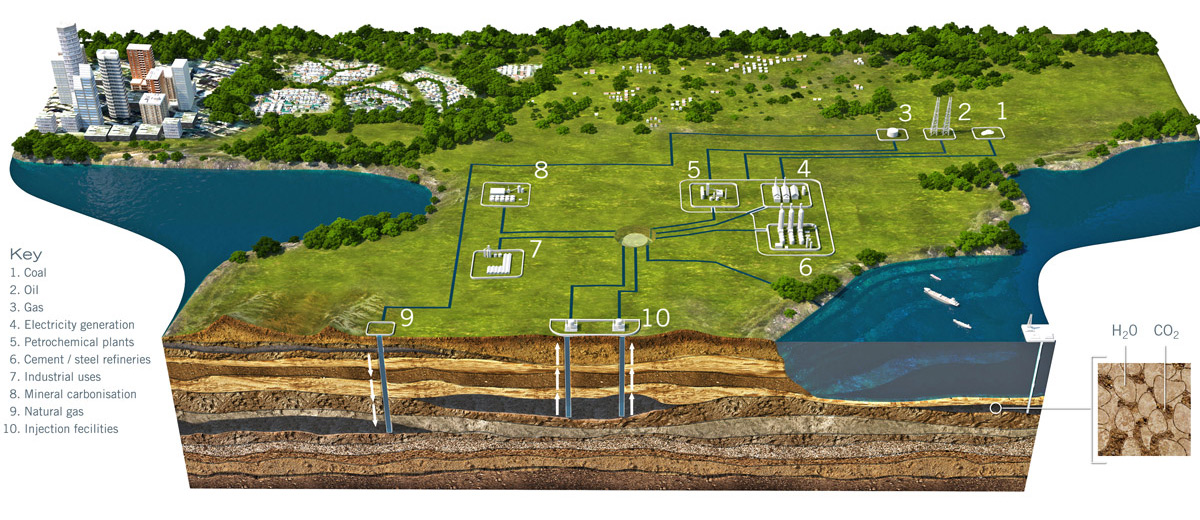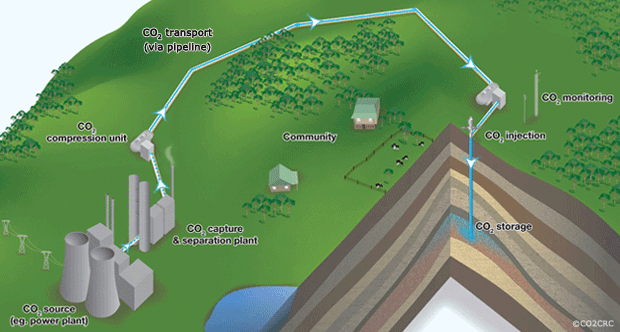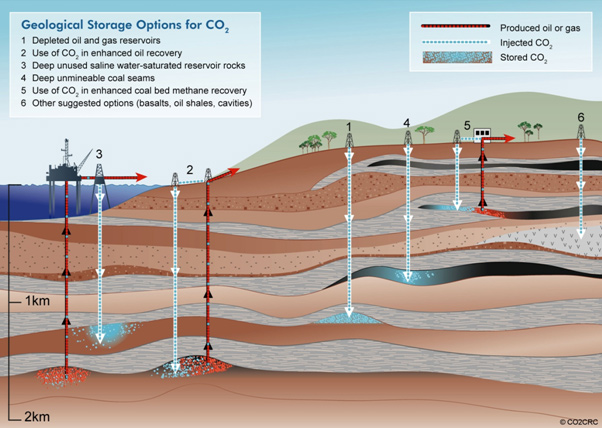> CO2 Capture and Storage (CCS)
What is CCS?
CCS is a technology to prevent large quantities of carbon dioxide or CO2 (a greenhouse gas) from being released into the atmosphere from the use of fossil fuel in power generation and other industries. The technology involves:
- collecting or capturing the CO2 produced at large industrial plants using fossil fuel (coal, oil and gas);
- transportation to a suitable storage site; and finally,
- pumping it deep underground to be securely and permanently stored away from the atmosphere in rock.

How CCS Works
CCS involves capturing the CO2 produced at large industrial plants from the burning of fossil fuel (coal, oil and gas), transporting it to a suitable storage site and pumping it deep underground.

1. Capture
Carbon capture is the separation of CO2 from the other gases produced when fossil fuel is burnt for power generation and in other industrial processes. |
2. Transport
Once separated, the CO2 is compressed and transported to a suitable site for geological storage or utilization. |
3. Storage
At its storage site, CO2 is injected into deep underground rock formations, often at depths of one kilometre or more. |
1: Capturing the carbon dioxide
Separating CO2 with solvent. |
Separating CO2 with a membrane. |
Capturing CO2 emissions from industrial processes is easiest at large industrial plants where CO2-rich flue gas can be captured at the facility.
The separation of CO2 is already performed in a number of industries as part of the standard industrial process. For example, in natural gas production, CO2 needs to be separated from the natural gas during processing. Similarly, in industrial plants that produce ammonia or hydrogen, CO2 is removed as part of the process.
In other industries, such as in steel mills and cement plants, capture processes have not yet been demonstrated at a large enough scale, but in each case an existing capture method can be tailored to suit the particular production process. For instance, collection of CO2 from cement plants uses post-combustion capture, and collection from modified steel manufacturing processes uses a type of oxy-fuel combustion.
As the largest contribution to CO2 emissions is from the burning of fossil fuel, particularly in producing electricity, three main processes are being developed to capture CO2 from power plants that use coal or gas. These are:
> post-combustion capture;
> pre-combustion capture; and
> oxy-fuel combustion capture.
Each of these processes involves separating the CO2 from the other waste gases. The main methods being developed are absorption using:
> a liquid solvent;
> a solid material; or
> membranes that can allow some gases through and not others.
2: Transporting the carbon dioxide
Once separated from other components of the flue gas, the CO2 compressed to make it easier to transport and store. It is then transported to a suitable storage site. Today, CO2 is already being transported by pipeline, by ship and by road tanker - primarily for use in industry or to recover more oil and gas from oil and gas fields. The scale of transportation required for widespread deployment of CCS is far more significant than this small-scale transport, and will involve the transportation of dense, concentrated CO2.
3: Storing the carbon dioxide

|
Geological storage options for CO2.
The final stage of the CCS process sees the CO2 injected into deep underground rock formations, often at depths of one kilometre or more. At this depth, the temperature and pressure keep the CO2 as a dense fluid. The CO2 slowly moves through the porous rock, filling the tiny spaces known as pore space.
Appropriate storage sites include depleted oil fields, depleted gas fields or rocks which contain fresh or saline water (saline formations). These storage sites generally have an impermeable rock (also known as a 'seal') above them. The seal and other geological features prevent the CO2 from returning to the surface.
These sites have securely contained fluids and gases for millions of years, and with careful selection, they can securely store CO2 for just as long.
Once injected, a range of sensing technologies are used to monitor the CO2's movement within the rock formations. Monitoring, reporting and verification processes are important to assure the public and regulators that the CO2 is safely stored.
Finding appropriate storage sites requires the collection of a great deal of data, and takes significant time and effort. Many economies around the world have active programs to identify storage sites for CO2, including the USA and Canada, China, South Africa, Australia and Europe.
Source: Global CCS Institute
Next page >>
TOP
|





